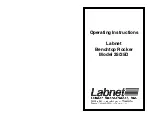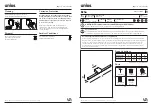
5
Transfemoral Static Bench Alignment
Standard TKA alignment can
be utilized with the trochanter
line bisecting the distal ankle.
Another alignment option is to
use a proximal sagittal socket
bisection 10 – 15 mm posterior
to the midfoot. The foot should
be aligned with 5° of toe out
(Figure 2).
Dynamic Alignment
It is important to align the
prosthesis so that the anterior
keel is loaded sufficiently to
provide dynamic response late
in stance. Some compression
of the C-spring is desirable
for optimal performance
and foot deflection may be more noticeable during dynamic alignment.
For a dedicated running or sport leg, 1/2 in. (12 mm) additional height
accommodates for spring deflection during high activity. Patient feedback
during this process is essential. Adjustments of the plantar/dorsiflexion
angles will help the patient achieve a smooth transition from heel to toe.
• Check for smoothness of gait and ground contact throughout the stance
phase of gait.
• If the heel rollover is delayed from heel strike to midstance, or the heel
compression is too great, dorsiflexion of foot may correct this problem.
• If the heel rollover is too rapid from heel strike to midstance, or the heel is
too hard, plantarflexion of the foot may solve this problem.
• If the heel rollover is too rapid from heel strike to midstance to toe loading,
increased plantarflexion may be required.
• If the heel rollover from midstance to toe loading is delayed, dorsiflexion
may be indicated.
• Check to make sure pylon is vertical in the frontal plane at midstance. If
there is a medial lean, tighten proximal medial screw; if there is a lateral
lean, tighten proximal lateral screw.
Figure 2
5°
2°
Summary of Contents for AllPro Foot
Page 1: ...AllPro Foot Product Manual...


























